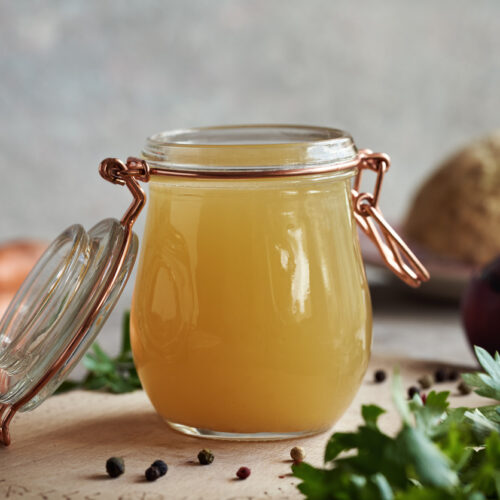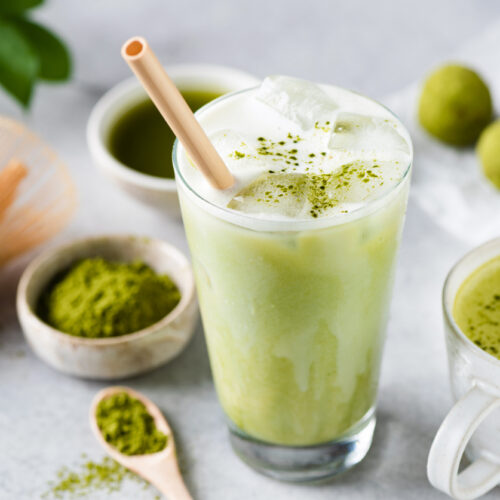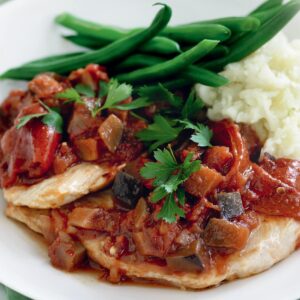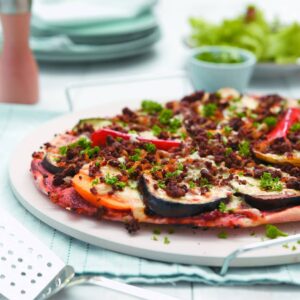
Scientific studies have shown that a low-FODMAP diet can significantly relieve irritable bowel syndrome (IBS) symptoms for many sufferers. In a new book, Dr Sue Shepherd and Dr Peter Gibson explain how to make it work for you.
Want to read more about FODMAPs and IBS? See our Low FODMAPs toolkit here, this is your complete guide to going low FODMAPs.
[This article was update in line with current low-FODMAP diet advice 9 May 2017]
Irritable bowel syndrome
What is IBS?
Irritable bowel syndrome (IBS) is one of a group of conditions called ‘functional gastrointestinal disorders’. This means that they cause disturbances in the function of the gut but don’t have any identifiable physical features such as ulcers, inflammation, thickening of tissues, lumps and bumps or abnormal blood tests — all of which would indicate a different condition. The diagnosis of IBS relies upon the types of symptoms experienced and their context, such as how long they have been experienced and when they occur.
What are the symptoms?
Sufferers can experience a broad range of symptoms including abdominal pain and discomfort, bloating, changes in bowel habits, heartburn, nausea, over-fullness and so on. Some of these symptoms originate in the upper gut (the oesophagus and stomach) while others originate in the bowel. Other symptoms or perceived symptoms can include excessive wind, unsatisfied defecation (incomplete emptying), passage of slimy mucus into the toilet bowl, a noisy abdomen (the noises are called borborygmi) and pain in the rectum. Tiredness is also common and its severity usually depends on that of the bowel symptoms. Muscle aches and pains (called fibromyalgia) occur in some people, while others experience an ‘irritable bladder’ (urinary frequency and urgency).
How does food affect IBS?
People with IBS often know that certain foods will trigger their symptoms and really want to know what they should or should not eat. It has been shown that dietary change is the major way in which sufferers of IBS attempt to help themselves. Unfortunately, until recently doctors tended to shy away from offering specific dietary advice, although they worked hard to eliminate poor eating habits (such as stress-filled meals or always eating on the run) and to avoid obvious dietary extremes (such as too many cups of coffee each day or a diet full of fat or devoid of fibre). Until the low-FODMAP diet, there was minimal scientific evidence that specific dietary changes helped people with IBS.
Dietitians with expertise in gastrointestinal nutrition and many doctors now recommend a low-FODMAP diet as a cornerstone of their treatment for people with IBS. The majority of IBS sufferers who have tried the diet have experienced greatly improved symptoms and a markedly reduced need for medication.
What are FODMAPs?
Certain food components can cause the bowel to distend by drawing in more fluid and rapidly generating gas when they are fermented by bowel bacteria.
The main dietary components that do this are known as fermentable, poorly absorbed short-chain carbohydrates. In other words, they are indigestible sugars that provide fast food for bacteria. Such sugars have been given the acronym FODMAP which stands for:
- Fermentable — rapidly broken down by bacteria in the bowel
- Oligosaccharides — fructans and galacto-oligosaccharides (GOS)
- Disaccharides — lactose
- Monosaccharides — fructose
- And
- Polyols — sorbitol, mannitol, xylitol and maltitol
If this seems too wordy to get your head around, just remember that ‘saccharide’ is simply another word for sugar. Polyols are what we call sugar alcohols — sugar molecules with an alcohol side-chain. You don’t need to know anything more than this. You may have heard of some of these sugars or seen them in ingredients lists.
How do FODMAPs contribute to IBS?
FODMAPs are ‘fast food’ for the bacteria that live naturally in the large bowel. The large bowel (and the lower part of the small bowel) naturally contains billions of bacteria. If molecules are not absorbed in the small bowel, they continue the journey to the large bowel. The bacteria that live there see these food molecules as ‘fast food’ and quickly break them down, which produces hydrogen, carbon dioxide and methane gases.
Multiple types of FODMAPs are usually present in any one meal. Because they all cause distension in the same way once they reach the lower small bowel and colon, their effects are cumulative. This means that the degree of bowel distension can depend upon the total FODMAPs consumed, not just the amount of any individual FODMAP consumed. If someone who cannot digest lactose well and absorbs fructose poorly eats a meal that contains some lactose, some fructans, some polyols, some GOS and some fructose, the effect on the bowel will be 1 + 1 + 1+ 1 + 1 = 5 times greater than if they ate the same amount of only one of those. That is why we have to consider all FODMAPs in food when modifying our diet.
What is a low-FODMAP diet?
A low-FODMAP diet has been shown to work in the treatment of IBS symptoms in both the short and long term. Once you know how to follow the diet, it is self-directed and self-empowering, meaning there are no ongoing costs for consultations or drugs.
Which FODMAPs should I avoid?
When you start a low-FODMAP diet you should avoid all FODMAPs — fructans, GOS, lactose, excess fructose and polyols. If you know you can completely absorb fructose, however, you need not restrict your excess fructose intake, and if you know you can completely absorb lactose, you need not restrict your lactose intake.
How much fruit can I eat at a time and how do I limit my fructose load?
You should eat no more than one serve of ‘suitable’ fruits (see DOWNLOADS) per meal or sitting. One serve is usually one metric cup of cut-up fruit, or one whole piece of fruit, such as one orange or banana. You can enjoy many fruit serves each day, but you should allow two to three hours between each serve.
Can I eat ‘table sugar’?
Table sugar (also called sucrose or cane sugar) should not cause symptoms if eaten in moderation. Sucrose is a double sugar made up of one part glucose and one part fructose. Large amounts of sucrose in one sitting may cause a problem for some people.
Do I really need to avoid onions and garlic?
Onion is one of the greatest contributors to IBS symptoms. We recommend that you strictly avoid onion for at least two months. This means not only cooking without onion, but also avoiding packaged foods that contain onion ingredients, such as onion powder in soups and stocks. Garlic also contains fructans and can contribute towards IBS symptoms. Unfortunately, you can’t cook with onion and garlic and then leave them on your plate, as this will only reduce the fructan load rather than remove it, since fructans can leach out of the onion and garlic into the other ingredients during cooking. During the initial strict phase of the diet, you should focus on cooking with low-FODMAP foods and avoid cooking with onion and garlic. You may find that you can reintroduce onion and garlic back into your diet, but it might only be in small amounts. In the meantime, an even better way to enjoy the taste of garlic, without the fructans, is to use garlic-infused oil.
Do I need to worry about fats and protein foods?
Fats and oils do not contain FODMAPs and nor do animal-based protein foods, such as meat, fish, chicken and eggs. However, plant-based protein foods, such as legumes and lentils, do contain FODMAPs and you may need to restrict your intake of these foods. FODMAPs typically occur in carbohydrate-based foods.
How do I avoid FODMAPs if I’m a vegetarian?
Vegetarians often consume large amounts of legumes as an important source of protein. However, these contain GOS and fructans. As there is a risk that your vegetarian or vegan diet will become nutritionally inadequate if you cut out legumes, your dietitian may advise you to allow a certain amount of these in your diet but exclude all other food sources of FODMAPs. The best approach will depend on your individual tolerance. Good news for vegetarians: firm tofu is low in FODMAPs, so can be included as a protein source.
Will a gluten-free diet help with IBS?
A gluten-free diet is often recommended as a way of managing the symptoms of IBS. Many people claim that it effectively relieves the symptoms of IBS, and there are plenty of websites promoting gluten-free diets as a cure for everything from IBS to chronic fatigue syndrome and autism. Often these claims are not backed up by any scientific evidence.
A gluten-free diet could improve symptoms of IBS as it removes fructans, a type of FODMAP. Well-designed scientific studies that produce validated evidence are needed before we can blame gluten for symptoms of IBS in people who do not have coeliac disease.
Must I really avoid wheat and rye products?
If you need to follow a low-FODMAP diet, you must avoid eating wheat and rye in large quantities. This means avoiding breads, cereals, pasta and biscuits, but you can still enjoy things like a breadcrumb coating on a chicken schnitzel, or wafer pieces in chocolate. A specialist dietitian can help assess your individual intolerance to wheat and rye products. The table on the next page gives common wheat-based products and suitable alternatives. Rye products contain fructans and so should be restricted. Some people, however, find they can tolerate rye bread, probably because we can eat only small portions of it at a time. Some people may tolerate small amounts of 100 per cent spelt sourdough bread. Once you have been on a low-FODMAP diet for several weeks and your symptoms have improved, it might be worth trying small amounts of rye and/or spelt products, to assess your own tolerance to them.
Foods suitable for a low-FODMAP diet
| Food | Suitable options |
| Fruits | Firm bananas, blueberries, grapefruit, grapes, honeydew melon, kiwifruit, lemons, limes, mandarins, oranges, passionfruit, paw paw, raspberries, rockmelon (cantaloupe), strawberries, tangelos, tomatoes |
| Vegetables | Alfalfa, bamboo shoots, bean shoots, bok choy, broccoli (less than 1/2 cup), capsicum (pepper), carrot, celery (less than 5cm), choko (less than 1/2 cup), choy sum, corn (less than 1/2 cob), cucumber, eggplant (aubergine), green beans, kumara (less than 70g), lettuce (butter, iceberg), olives, parsnip, potato, Japanese pumpkin (squash), silver beet, spinach, spring onion (green part only), squash, swedes, taro (less than 1/2 cup), tomatoes, turnips, yams |
| Milk products | Lactose-free milk, rice milk, almond milk, ‘hard’ cheeses including brie and camembert, lactose-free yoghurt, gelato*, sorbets*, butter and margarine
*check for high FODMAP fruit and sweeteners |
| Grain foods | Gluten-free bread and cereal products, arrowroot, buckwheat, corn (maize), millet, rolled oats (less than 1/2 cup), polenta, potato, quinoa, rice, sorghum |
| Sweeteners | Sugar (sucrose), glucose, pure maple syrup, stevia, any other artificial sweeteners not ending in ‘-ol’ (eg. aspartame) |
| Other | Garlic-infused oil as an onion and garlic substitute, fresh and dried herbs and spices, chives, ginger |
FODMAP-containing foods and suitable alternatives
| Food | Varieties containing FODMAPS | Suitable alternatives |
| Flours, grains | Flours, wheat and legume products, grains including barley, bulgar, chickpea flour (besan),* couscous, durum, kumat, lentil flour,* multigrain flour, pea flour,* rye, semolina, soy flour,* triticale, wheat bran, wheat flour, wheaten cornflour, wheatgerm.
*These contain GOS and fructans, but in small amounts as part of a recipe do not cause IBS symptoms in most people. You should assess your own tolerance. |
Arrowroot, buckwheat flour, cornflour and cornmeal (maize), custard powder, glutinous rice, ground rice, oat bran, oatmeal, oats, polenta, potato flour, quinoa, rice (brown, white), rice bran, rice flour, sago, tapioca |
| Cereals | Wheat-based and mixed-grain breakfast cereals, bulgar, couscous, muesli, semolina | Rice-based or corn-based breakfast cereals, rolled oats (porridge), baby rice cereal, wheat-free muesli (with minimal amounts of suitable dried fruit) |
| Pasta, noodles | Noodles, pasta, gnocchi | Mungbean (glass) noodles, rice noodles, rice vermicelli, soba noodles, gluten-free pasta |
| Breads, biscuits, cakes | All breads, biscuits, cakes, muffins, croissants, crumpets and pastries containing wheat and rye, sourdough commercial breads, breadcrumbs | Gluten-free breads, taco shells, maize tortillas, plain rice cakes and crackers, gluten-free biscuits, gluten-free cakes and pastries* *Check for additional high FODMAP ingredients like high FODMAP fruits and sweeteners |
| Dairy foods, alternatives | Regular milk, ice cream, soft cheeses (in large quantities), yoghurt | Lactose-free milk, rice milk, almond milk, calcium-fortified soy milk (made from soy protein), lactose- free ice-cream, hard cheeses, most lactose-free yoghurts, firm tofu |
| Meat, equivalents |
Sausages and other processed meats (check for onion and dehydrated vegetable powders) | Plain red meat, fish, poultry, bacon, eggs |
| Nuts, seeds | Pistachios, cashews | Most other nuts and seeds |
| Fruit, veges | See table above | See table above |
| Spreads, condiments | Most commercial relishes, chutneys, onion-containing gravies, stock cubes, dressings and sauces, honey, jam made from high-FODMAP fruit | Strawberry jam, marmalade, golden syrup (less than 1/2 tablespoon), maple syrup, peanut butter, soy sauce, tamari, vinegar |
| Beverages | Coffee substitutes, large quantities of fruit juice, apple, pear and mango juices | Water, rice milk, mineral water, soda water, soft drinks, tonic water, fruit juice (safe fruits only, 125ml per serve), tea, coffee, most alcohols |
| Fats, oils | Large amounts of margarine and dairy whip/table spread | Vegetable oils, butter, ghee, lard, dripping, small serves of cream |
| Others | Baking powder, baking soda, cocoa, gelatine, pure icing sugar, salt, xanthan gum, herbs, spices |
Want to read more about FODMAPS and IBS? See our FODMAPs Toolkit here.
Nutritionist’s note
Not all gut symptoms relate to IBS. It’s important to get a confirmed diagnosis from a health professional. A low-FODMAP diet is not suitable for everyone with IBS, can be difficult to do without help and can be very restrictive nutritionally if care is not taken.
www.healthyfood.com










